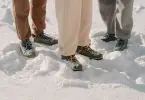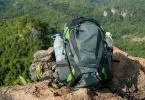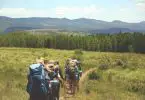You have looked for weeks for those new hiking shoes and you’ve finally found them. They have a great design and they are very comfortable, you have tried them at home. Now you are ready to go on a long planned backpacking trip with your friends.
There is just one thing; after an hour in those perfect hiking shoes they are not as comfortable as they were at home. And that is not the only thing, you feel as though you are stepping on a thorn with every other step you make. If shoes are hard on your feet, check out our reviews of the top hiking sandals for a more comfortable trek.
We’ve all been there, you developed a blister. But don’t worry; even though you are not prepared for it, there are herbs in nature or items in your backpack suitable for situations like this. This article will teach you how to care for a blister even though you are in nature where resources are limited.
A blister is usually a small bubble filled with fluid that is located right under your skin. It is most often created with the process of rubbing your foot or hand, against some hard object.
It happens after long walks, running, repeating the same movements in a workout, or wearing clothes or shoes inappropriate for the person wearing it. A blister on a foot is a nasty and uncomfortable sore that could happen to anyone who is keen on walking long distances.
See also: Gore Tex Hiking Shoes: No More Blisters, Just Hiking
In fact, probably there isn’t a person in this world that hasn’t had a blister. The crisis comes when there is no one around that knows how to treat one without medications or some aids from the pharmacy. Luckily, Mother Nature provided us with natural medication for every disease.
First Aid for A Blister
Chamomile
Chamomile protects the skin and helps in healing all kinds of wounds on the skin. In addition, it is often found in nature and can be of great help in treating blisters. These properties of the chamomile make it the number one reason why it is commonly used in cosmetic products intended for the skin.
So if you happen to have a blister while in nature, find some chamomile flowers, mix them with water, and put this mixture directly on the blister. It will calm your skin down and will speed the recovery process.
Tea tree for healing a blister
If you managed to go through the day with a blister on your foot or hand but you are not planning on taking it one more day, tea tree is the right medicine for you. You will probably not find this tree in nature, but it is good if you include it in your essentials for every trip you take. Besides being good for blisters, it is also antibacterial and can treat every other wound.
The antibacterial properties of this oil protect the skin from infections and will speed up the recovery process. In normal conditions, popping a blister is not recommended since it can introduce bacteria in the affected area. But if you happen to have tea tree oil with you, you can do this and apply some of the oil on the wound. It will hurt a little, but after this, you’ll be as good as new.
Toothpaste as a blister remedy
This is not quite natural, but it certainly is effective. If you have an itching blister then try this anti blister recipe. White toothpastes contain ingredients like baking soda, hydrogen peroxide, alcohol and mint. These ingredients can ease the sense of itching and they will also contribute to the blister being healed quicker.
The only thing you have to do is put some paste on the blister and let it sit down for couple of hours. Not every toothpaste’s ingredients are the same. Read the ingredient list before applying. Avoid using whitening pastes.
Sage
Sage is an herb that is very common in nature and is used for treating every skin condition with fluid inside. It has absorbing and sucking properties.
So if you manage to find sage leaves in your area you will do yourself a great favor. In addition to treating blisters, sage is also used for herpes.
Deodorant as Blister Prevention
If you are going on a several-day hiking trip, then you must have deodorant with you. It is common knowledge that blisters and moisture are close friends.
That is why almost any product that keeps your skin dry will do the trick. Apply some deodorant before you put on your shoes and you should have no problem with blisters.
Cover it to protect it
If you check in your first aid box you will certainly find some bandages. Cover the blister with a bandage which will act as a first line of defense.
It will act as a barrier between the hard surface touching the blister and the blister itself. It will not cure it, but it will definitely relieve you of the pain you are feeling.
Witch Hazel for blister healing
This is also a common herb in some areas. If you have the luck of finding witch hazel flowers, apply it on the blister and cover it with a bandage.
Witch hazel contains astringent tannins that will promote healing it. It will dry it over time as well.
Aloe vera gel
This is more of a home remedy than a treatment for a blister in the wilderness. Aloe vera is a natural healer and among other things it promotes blister healing as well. It has anti inflammatory properties that help reduce the redness and swelling caused by the blister. It also hydrates the skin and quickens the healing process. In addition to this, it reduces the risk of an infection.
If you decide on this method, the most effective way of using it is by mixing it with vitamin E oil. First mix the aloe vera gel and vitamin E oil in equal parts. Put it on the blister and let it dry itself. This mixture should be applied several times a day. The blister will disappear and there won’t even be a scar.
Apple cider vinegar
There is a good probability that you have apple cider vinegar. Apple cider vinegar is an efficient medicine against blisters because of its antibacterial and anti inflammatory properties. It stops and prevents infections but also relieves the pain and inflammation if there is any.
In order to treat a blister with apple cider vinegar, cover a cotton pad with apple cider, put it directly on the affected area and cover it with a bandage. It should be applied as many times as possible.
Green tea leaves
Green tea has anti inflammatory properties that can ease the pain and swelling that are usually present when a blister appears. In addition it contains vitamins and antioxidants that help the wound heal faster. If you are at home, put one bag of green tea in a small amount of water and leave it in for 3 minutes.
Let it cool down and after that put the bag on the blister. Leave it on until you no longer feel the pain. Repeat this during the day until you feel better.
Epsom salt
Epsom salt is the safest way of treating a blister. It helps in drying blisters that still aren’t popped but it also eases the draining process. It contains high levels of magnesium which also relieves pain, inflammation and swelling. It also prevents infections.
This is also a home remedy.
- Pour 1 to 2 teaspoons of Epsom salt in a foot bath that is warm enough but not too hot and mix it well.
- Put your feet in and hold them under water for at least 15 minutes.
- After soaking, dry your feet well and apply a layer of paraffin gel or vitamin E oil.
- Repeat the treatment 2 times a day.
- When the blister pops Epsom salt will cause a tingling feeling. The treatment should be stopped if this is the case and proceed to another treatment.
Castor oil
Another efficient home remedy for blisters is castor oil. This oil maintains the humidity in the affected area.
Therefore, it assists in the healing process and reduces the itching. Simply put castor oil on a cotton pad and cover it with a bandage. Leave it this way for it to operate all night. In the morning the blister should be gone.
Curcuma
If you are backpacking and camping this spice would be the perfect choice for you. It will cure a blister if it appears and in the same time make your meals taste better. Curcuma is a powerful spice with such varied properties.
It heals and eases pain and inflammation. It is also an antiseptic and prevents infections which can cause more serious conditions. If you decide on using this spice as a remedy:
- Mix half a teaspoon of curcuma with enough water to make a paste. Apply this paste on the blister and leave it on for 10 to 15 minutes. After that rinse with warm water.
- Repeat this treatment 3 times a day, for several days if needed.
- If you are eager for the blister to go away faster, you can add warm curcuma milk to the menu and drink it before going to bed. It will increase its healing properties and decrease the recovery time.
Moleskin tape
If you haven’t used moleskin tape before, make sure to include it in your first aid kit. You will find it more useful than any other remedy.
It is a soft cushion that acts as a barrier between the blister and the object that created the blister. It is kind of like a bandage but in a tape form so you can cut a round form if it is more suitable for you.
Cold water and a cloth
If you don’t have anything from this list at your disposal, then a clean cloth and cold water will have to be enough. It will keep the blister cold and it will ease the pain you are feeling.
Additional Methods that Help in The Healing Process
- It is recommended that every wound, blisters included, be left to breathe while in a clean environment. So as soon as you get home or in a comfortable space, like a tent for example, remove the bandages or moleskin tape and let it breathe. This way, if the fluid bubble is already popped, it will heal faster.
- Keep your blister clean and wash it more frequently only with soap and water. After washing you are allowed to apply antibacterial cream or natural products.
- Every bandage and every remedy put on the blister should be regularly changed. Otherwise it might change the skin and create an environment for an infection
- If a blister pops, it is only natural that you would want to remove the excess skin left behind. This is a great “no”. This remaining skin even though it doesn’t look too good, will act as a natural protection from further infection and irritation of the wound. All things considered, it is best that you resist the urge.
- If you have a blister and you have a river crossing ahead of you, cover the blister as much as you can. There is no way you can be sure what kind of germs can be found in the water. Protect the blister by covering with a bandage and if possible make sure your shoes don’t get wet. If that is not possible, after crossing the river, disinfect your wound with betadine or any antiseptic available to you from your first aid kit. See also our tips on how to choose the top first aid kit to give you more options.
Prevention as The Best Cure for A Blister
- To prevent a blister put some baby cream against rash on the places that are critical or a paraffin layer.
- Always wear socks with a new pair of shoes. This seems obvious, but you will be surprised how many people hate wearing socks with shoes.
- Avoid repeated movements on a certain skin surface because it can be irritating to the skin.
- No one asks for a blister but small shoes will certainly give you a blister. Wear your shoes for a day before going on a backpacking trip for instance. Don’t just try them on. Almost every shoe is comfortable when you are only standing in them for a short period of time
- If you are prone to getting blisters, make it a habit to use dying agents like talc or aluminum chloride and apply frequently before any activity that involves using your feet.
- Believe it or not, there is actually a lacing system against blisters. This system creates an equal pressure on the whole foot, thus preventing a blister on a specific spot. Take into account that there is no guarantee that with this system you will prevent a blister, but it is worth the try.
- This is probably something every experienced hiker already knows, but it can serve as a reminder. While hiking, avoid wearing cotton socks, instead choose liner socks for trips in nature because they don’t absorb sweat and they dry easily. Polyester socks are also acceptable.
Treating Your Blister
- Clean the affected area with alcohol or hydrogen peroxide and after that cover it with a clean bandage.
- After the damage is done, avoid exercises that will make the blister condition worse.
- When removing the bandage or moleskin tape, be careful not to remove the remaining skin and create a new wound.
- If symptoms of infection occur, such as strong pain, swelling, extreme redness around the affected area or fever, immediately go to a doctor for further treatment.
- Do not try to drain the blister. It will hurt very much and it won’t make you feel any better.
- In some cases, depending on the environment and activity ahead of you, it is okay to pop a blister. Popping a blister is not recommended, but it is a better option than making a bigger one.
- If blisters appear on your arms or some other part of your body, wear gloves or use elastic bandages to act as a barrier for the constant irritation movement.
The most important thing is to know that even though blisters can create an irritating pain with every movement, in most cases, it is not a big deal. Most people get terrified by imagining the naked skin rubbing from their shoe.
You can choose to treat a blister in any of the above suggested ways, only keep in mind that some treatments are not to be combined. It is best if you use one treatment at a time. Also, make sure you respect the daily dosage of the suggested ingredients.
Even though they are natural and they can do you little harm, over dosage can be irritating to your skin and worsen the condition. Before you head to your next trip, check out our must-read article on how to break-in camping boots to help prevent blisters.
Featured Image Source: https://www.flickr.com/photos/16105436@N00/459027963








